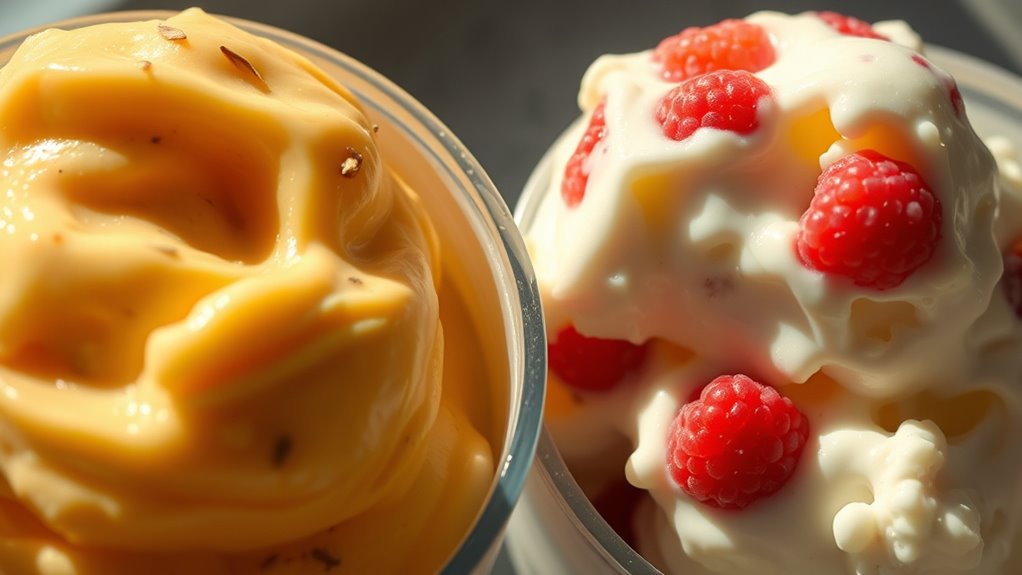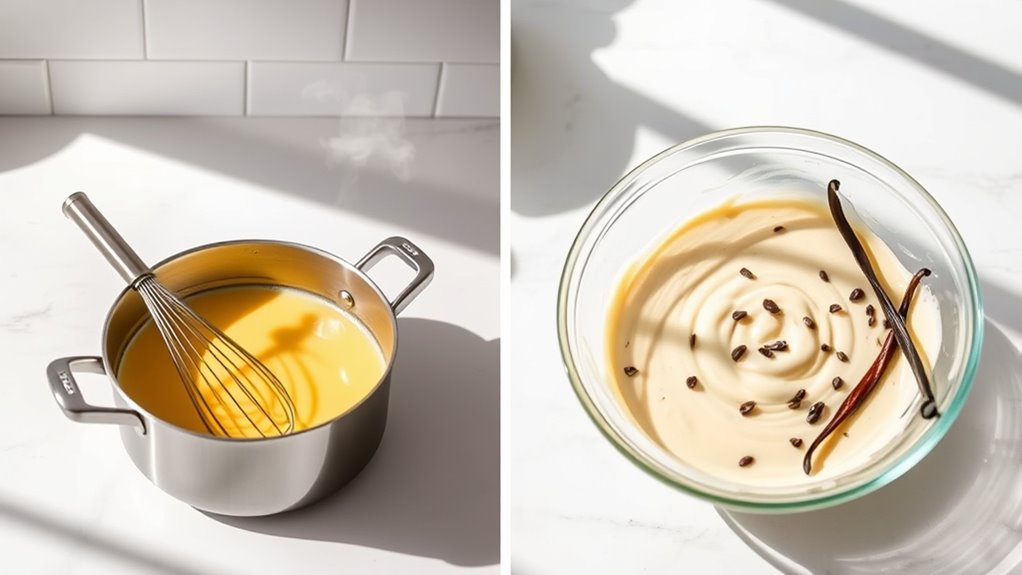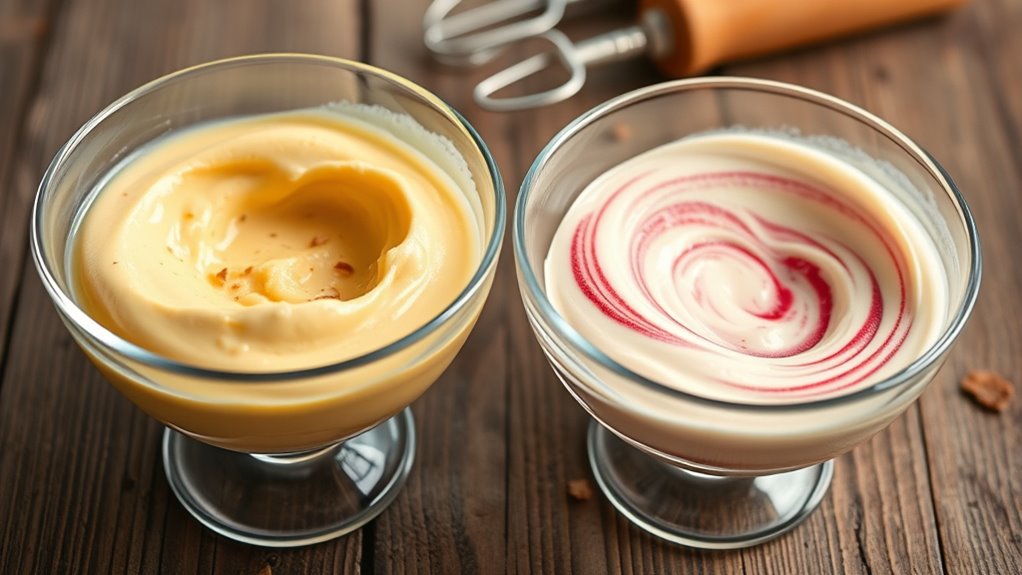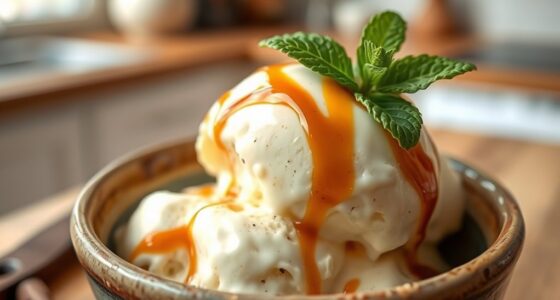When mastering homemade ice cream, custard and no-cook methods each offer unique benefits. Custard, made with eggs, cream, and milk, gives you a rich, creamy texture and deeper flavors due to the cooking process. On the other hand, no-cook styles are quicker and simpler but can be lighter and icier. You’ll find both options versatile for customization with flavors and mix-ins, allowing you to create your perfect treat. Discover more about these styles and their nuances.
Key Takeaways
- Custard ice cream uses egg yolks for richness and smoothness, while no-cook versions are lighter and icier without them.
- The cooking process for custard ensures flavor depth and a creamy texture, unlike the simpler no-cook method.
- No-cook ice cream is quicker to prepare, as it involves mixing ingredients without cooking, saving time in the kitchen.
- Flavor enhancements like spices and fruits can be added to both styles, but custard offers a deeper, more complex flavor profile.
- Proper storage is crucial for both types, with airtight containers and maintaining a temperature of 0°F (-18°C) or lower for freshness.
Understanding Custard Ice Cream: Ingredients and Composition

When you plunge into the world of custard ice cream, you’ll find that its rich and creamy texture comes from a blend of key ingredients. The foundation includes milk, cream, egg yolks, sugar, and flavorings like vanilla. Frozen custard is made with eggs, milk, whipping cream, flavoring agents, and sugar. Eggs act as emulsifiers, enhancing the ice cream’s smooth consistency and richness. You’ll need to cook the base to guarantee safety and avoid any graininess, tempering the eggs with warm milk for the best results. This cooking process, alongside the heavy cream, contributes to custard ice cream’s denser texture compared to standard varieties. Following FDA guidelines, you’ll appreciate the balance of flavors and the luxurious mouthfeel that sets custard apart in the homemade ice cream world.
The Texture and Consistency of Custard vs. No-Cook Ice Cream

Custard and no-cook ice cream each offer distinct textures and consistencies that cater to different preferences.
Custard ice cream is rich and creamy, thanks to egg yolks that enhance thickness and smoothness while preventing ice crystals. This results in a denser product that maintains its texture better when frozen. However, thick custards may require careful attention during the churning process to ensure optimal results.
Custard ice cream’s richness and creaminess come from egg yolks, creating a dense, smooth texture that resists ice crystals.
On the other hand, no-cook ice cream tends to be lighter and icier, as it lacks egg yolks, unless stabilizers are added. During churning, custard requires careful handling to avoid over-whipping, while no-cook versions can become too airy if over-churned.
Ultimately, if you seek a luxurious, velvety experience, custard is your best bet, while no-cook ice cream offers a simpler, airier alternative.
Flavor Enhancements: Depth and Variety in Ice Cream Bases

Flavor enhancements play an essential role in elevating homemade ice cream, allowing you to explore a world of depth and variety. You can infuse dairy with spices, herbs, or tea for complex flavors. Using ingredients like vanilla beans deepens the profile, while fresh fruits add vibrant color and natural sweetness. Incorporating custard-based ice cream can also provide a rich, creamy texture that enhances the overall flavor experience. Additionally, utilizing high-quality equipment can ensure that your ice cream base is consistently well-mixed and aerated.
Don’t forget about unique spice blends and herbal infusions for invigorating twists. For added texture, mix in chocolate chips, nuts, or fruit swirls. A drizzle of caramel enriches the experience, and balancing sweet elements with a touch of sea salt or citrus zest creates exciting contrasts.
Experimenting with flavor combinations and using specialty ingredients can push your ice cream to new heights, ensuring every scoop is a delightful adventure.
Preparation Complexity: Cooking Custard vs. No-Cook Methods

While cooking custard might seem challenging at first, it offers a rich and creamy base that many ice cream enthusiasts cherish. You’ll need eggs, milk, cream, sugar, and often vanilla, and the cooking time ranges from 10 to 20 minutes. Watch the temperature closely; it should reach 170°F to 180°F to thicken properly. You’ll temper the eggs to avoid scrambling, and straining the mixture guarantees a smooth texture. Additionally, a classic custard ice cream recipe often includes various flavorings like vanilla or fruit purees, enhancing the overall taste experience.
On the other hand, no-cook methods are simpler. You mix cream, milk, sugar, and vanilla cold, saving time by skipping cooking and cooling steps. However, be aware that no-cook ice cream might be icier and lack the depth of flavor that cooked custard brings. Choose based on your preference for complexity!
Storage and Shelf Life: Maintaining Quality in Ice Cream

To keep your homemade ice cream fresh and delightful, proper storage is essential. Use airtight containers made from plastic, glass, or metal, ensuring they’re tightly sealed. Consider adding plastic wrap for extra protection and choose containers that allow easy portioning. Store your ice cream at 0°F (-18°C) or lower, and position it in the coldest part of the freezer, away from the door. Minimize air exposure by filling containers to the top and avoid gaps within them. Limit opening the freezer to maintain consistent temperature and regularly check for spoilage. With proper storage, your homemade ice cream can last 2 to 3 months while maintaining its delicious quality. Additionally, aging ice cream bases can lead to a thicker base, which may contribute to a smoother texture and reduced melting during storage.
Customization and Versatility: Exploring Flavor Profiles and Mix-Ins

When you immerse yourself in homemade ice cream, the possibilities for customization are nearly endless. Start with a vanilla or chocolate base, then let your creativity flow. Toss in fresh fruits like strawberries or cherries, or add nuts for crunch. Nuts like almonds and walnuts enhance the flavor and texture of your ice cream, making it even more delightful.
Don’t shy away from mixing in candy pieces or cookies to create your dream dessert. Try folding in delicate ingredients or swirling fudge for visual flair. Custard’s richness pairs beautifully with caramel and toasted nuts, while no-cook methods let herbs shine through.
Experiment with textures by layering different mix-ins or chilling them beforehand. You can also use coconut cream or almond milk as bases for quick, versatile options. Immerse yourself and make your ice cream uniquely yours!
Frequently Asked Questions
Can I Substitute Egg Yolks in Custard Recipes?
Yes, you can substitute egg yolks in custard recipes. Options include cornstarch, which stabilizes and thickens, or cream cheese, which mimics some properties of egg yolks.
If you’re looking for a plant-based alternative, full-fat coconut milk, avocados, or bananas can add creaminess.
While these substitutes won’t fully replicate egg yolks’ emulsification, combining a few might help achieve a richer texture.
Experiment and see which alternative suits your taste and dietary needs best!
How Do I Prevent Ice Crystals in No-Cook Ice Cream?
Preventing ice crystals in no-cook ice cream is like keeping a smooth lake on a calm day.
Start by chilling your base before churning; this helps maintain a creamy texture. Use high-fat ingredients and sugar to bind water, minimizing ice crystal growth.
Rapid freezing is key, so make certain your ice cream maker’s bowl is pre-chilled.
Finally, store your ice cream properly by keeping it sealed and at a consistent low temperature.
What Tools Do I Need for Making Custard Ice Cream?
To make custard ice cream, you’ll need a few essential tools.
Start with a blender or food processor for smooth mixing. A digital scale helps you measure ingredients accurately. Use heat-resistant utensils and a thermometer to control cooking temperatures.
An electric ice cream maker automates the churning process for a creamy texture. Finally, have freezer-safe containers ready for chilling and storing your delicious creation.
Get these tools, and you’re set!
How Long Does It Take to Churn Ice Cream at Home?
Imagine you’ve just mixed a fresh ice cream base and you’re excited to taste it.
Churning your ice cream at home typically takes about 15 to 30 minutes with an electric maker. You’ll know it’s ready when the motor slows down and the mixture starts to expand.
For manual methods, it might take an hour or more. Just remember, the longer you churn, the smoother your final treat will be!
Can I Freeze Custard Ice Cream in Plastic Containers?
Yes, you can freeze custard ice cream in plastic containers.
Just make sure they’re food-grade and BPA-free to avoid any contamination. The flexibility of plastic helps manage temperature changes, while airtight lids prevent freezer burn.
If you want to keep your ice cream smooth, consider using an additional layer of plastic wrap or freezer bags.
Remember to store it at a consistent temperature below 0°F (-18°C) for the best results.
Conclusion
In the battle of custard versus no-cook ice cream, each style brings its own unique charm to the table. Whether you crave the rich, creamy texture of custard or the quick convenience of no-cook methods, mastering these bases opens up a world of flavor possibilities. So, why not experiment with your favorite mix-ins and create your perfect scoop? With a little creativity, you can enjoy delicious homemade ice cream just the way you like it!










